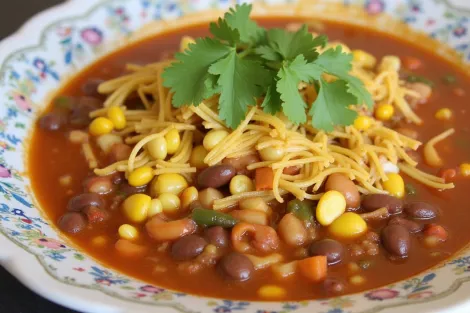Introduction: The History and Origins of Vegetarian Chili
Chili has long been a staple of American and Mexican cuisine, known for its bold flavors, rich spices, and hearty texture, vegetarian chili has emerged as a delicious and nutritious alternative, offering the same comforting warmth without the meat.
The origins of chili date back to indigenous Mesoamerican cultures, where native ingredients like beans, tomatoes, and chili peppers were essential to their diets. As chili gained popularity in the United States, particularly in Texas, different variations emerged, including plant-based versions that cater to vegetarians and health-conscious eaters. Today, vegetarian chili is enjoyed worldwide, praised for its balance of protein-packed legumes, vibrant vegetables, and aromatic spices.
Table of Contents

Ingredients:
The secret to a flavorful vegetarian chili lies in its ingredients. Below is a detailed ingredients list, including healthy and budget-friendly alternatives to suit different preferences.
| Ingredient | Quantity | Healthy Alternative | Budget Alternative |
|---|---|---|---|
| Olive oil | 2 tbsp | Avocado oil | Vegetable oil |
| Onion (chopped) | 1 medium | Shallots | White onion |
| Garlic (minced) | 4 cloves | Fresh garlic | Garlic powder |
| Bell peppers (red & green) | 2 medium | Organic bell peppers | Any color bell pepper |
| Carrots (diced) | 2 medium | Sweet potatoes | Regular carrots |
| Celery (chopped) | 2 stalks | Kale or spinach | Skip if unavailable |
| Diced tomatoes (canned) | 2 cans (14 oz) | Fresh tomatoes | Store-brand canned tomatoes |
| Tomato paste | 2 tbsp | Fresh blended tomatoes | Store-brand tomato paste |
| Black beans (cooked) | 1.5 cups | Kidney beans | Canned black beans |
| Red kidney beans (cooked) | 1.5 cups | Pinto beans | Canned kidney beans |
| Corn kernels | 1 cup | Fresh corn | Frozen or canned corn |
| Vegetable broth | 2 cups | Low-sodium broth | Water with bouillon cube |
| Cumin powder | 1 tsp | Whole cumin seeds | DIY spice blend |
| Chili powder | 2 tbsp | Smoked paprika | Regular chili flakes |
| Oregano | 1 tsp | Fresh oregano | Dried mixed herbs |
| Cayenne pepper | 1/2 tsp | Red pepper flakes | Skip for mild flavor |
| Salt and black pepper | To taste | Himalayan salt | Regular table salt |
| Fresh cilantro | 1/4 cup | Parsley | Skip if unavailable |
| Lime juice | 1 tbsp | Fresh lime | Bottled lime juice |
Step-by-Step Cooking Instructions
1. Sauté the Aromatics
- In a large pot, heat the olive oil over medium heat.
- – Add the chopped onion and sauté it until it softens, approximately for 3-4 minutes.
- – Add the minced garlic and cook it until it becomes fragrant.
2. Cook the Vegetables
- Add the bell peppers, carrots, and celery to the pot.
- Sauté for 6 minutes, stirring occasionally, until the vegetables begin to soften.
3. Build the Base with Tomatoes
- Add the chopped tomatoes and tomato paste.
- Cook for 3-4 minutes, allowing the tomatoes to release their juices and intensify in flavor.
4. Add Beans and Broth
- Pour in the black beans, kidney beans, and corn.
- Add the vegetable broth, stirring well to combine.
5. Season the Chili
- Stir in the cumin, chili powder, oregano, cayenne pepper, salt, and black pepper.
- Bring the chili to a simmer and cover.
- Let it cook for 30-40 minutes, stirring occasionally to prevent sticking.
6. Adjust and Finish
- Taste the chili and adjust the seasoning if necessary.
- Stir in the lime juice and fresh cilantro for a burst of freshness.
- Allow the chili to rest for 5 minutes before serving.
Nutritional Value and Health Benefits
Vegetarian chili is a powerhouse of nutrients, fiber, and plant-based protein, making it a great option for both vegetarians and omnivores.
- High in Fiber: Beans and vegetables provide excellent digestive health benefits and promote satiety.
- Rich in Plant-Based Protein: The combination of beans and corn delivers a well-balanced protein profile.
- Loaded with Antioxidants: Tomatoes, bell peppers, and spices contain essential antioxidants that help fight inflammation.
- Heart-Healthy: Low in cholesterol and rich in potassium, this chili supports cardiovascular health.
For a lower-calorie version, reduce the amount of oil and increase the vegetable-to-bean ratio. For extra protein, consider adding quinoa or lentils.
Serving Suggestions and Food Pairings
To elevate your vegetarian chili, try serving it with the following:
- Side Dishes: Brown rice, quinoa, or warm cornbread.
- Toppings: Avocado slices, shredded cheese, or a dollop of Greek yogurt.
- Drinks: A refreshing hibiscus tea (agua de Jamaica) or a citrus-infused sparkling water.
Final Thoughts
This vegetarian chili An ideal blend of delicious, nutritious, and satisfying flavors. Whether you’re serving it on a chilly evening or as a meal prep option for the week, it’s a dish that will never disappoint. Try this recipe today and experience the bold, comforting flavors of plant-based cooking!

